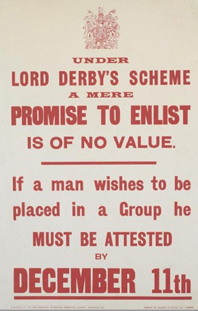
Derby Scheme Poster from November 1917
Charles enlisted in Woodbridge around December 1915 under the Derby Scheme where men could volunteer to serve but have their mobilisation date postponed. These volunteers were grouped by age and whether they were married or single – young, single men were the first to be mobilised. Charles’ age group was mobilised on 20th January 1916. After training with the Suffolk Regiment’s training battalion, Charles was posted to join the 2nd Suffolks as reinforcements for casualties suffered during the start of the Battle of the Somme. The war diary shows that on 20th July 1916, sixty-three OR (Other Ranks) arrived as reinforcements, joining the battalion in billets in Bois de Tailles.
In order to integrate the new arrivals with the “old hands”, the battalion went into a period of training – this did not go well. One hundred and sixty men from the “Bantams” had also been sent as reinforcements, which caused the battalion some further problems. On 4th August, the battalion undertook a seven-mile route march as part of their training. (Click here for information on Bantam Battalions)
The following comment is in the war diary:
“Bantam drafts a hindrance to others in the ranks.”
The situation did not improve when, one week later, the battalion moved to Sandpits Camp to train for an attack.
“11th August: Left Merricourt L’Abbe arrived Sandpits 6.30pm and bivouacked. Bantam draft unable to step with others were fallen out and marched behind as a party.”
“12th-13th August: Sandpits – practised companies in extended order and once in attack. Their knowledge of either was practically nil.”
The following day the battalion was at the front line. Of the seventeen officers and seven hundred men deployed, this was to be the first time in the trenches for four of those officers and over half of the men. On 14th August, the Battle of Maltz Horn Farm began and, over the next five days, the battalion was in fierce fighting with the enemy. By the time they were relieved on the 19th August, their casualties were as follows: one officer – Lieutenant Alexander Ellis Walford of Melton – killed; eight other officers wounded and nine missing; thirty-nine OR killed, one hundred and fifty-one wounded and eighty missing. One of the wounded was Charles Cone, although there are no details as to how badly he was hurt. Once he had received treatment, Charles went back to his battalion.
In August 1918, the war was coming to an end and the One Hundred Days Offensive was about to commence. On 30th August, the 2nd Suffolks were at the front line poised for an attempt to capture Ecoust-le-Mien. By 07:00 the objective had been taken but the tank support they had been promised was withdrawn before the attack started. In addition, the other battalions involved had not made up the expected ground, leaving the 2nd Suffolk's flanks exposed. Despite having taken over one hundred and thirty prisoners, their position was precarious and a German counterattack forced them back to where they had started earlier that morning. The battalion’s casualties were reported at the time as being over two hundred men. Charles Henry Cone was posted as missing and later as “presumed dead”. His body was not recovered; he is remembered on the Vis-En-Artois Memorial, France and the Melton War Memorial.
For his war service, Charles received the British War and Victory Medal.
